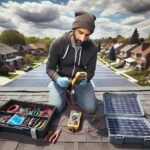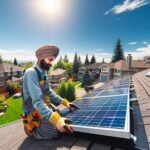Imagine slashing your utility bills while contributing to a greener planet—sounds appealing, doesn’t it? With the average installation cost of solar panels in Canada hovering around CAD 22,500, many homeowners wonder if the savings and environmental benefits truly outweigh the initial investment. Can you really achieve energy independence and long-term financial gains by going the DIY route?
Surprisingly, government incentives and rebates can significantly reduce these upfront costs, making solar energy more accessible than ever. But is the DIY approach practical for the average Canadian homeowner, or does it come with hidden pitfalls? Let’s investigate into the pros and cons of DIY solar installation and see if it’s a viable option for you.
Understanding DIY Solar Installation
Interest in DIY solar installation is heating up among Canadian homeowners. But what does it entail, and is it right for you? Let’s break it down.
What Is DIY Solar Installation?
DIY solar installation involves you taking the reins of your solar panel project. This means sourcing solar panels, installing them, and connecting them to your home’s electrical system all by yourself. Sounds daunting? It can be, but it’s also a way to potentially save on labor costs associated with professional installations.
 secrets to maximizing solar efficiency in canada’s climate
secrets to maximizing solar efficiency in canada’s climateYou start by researching the best solar panels suitable for your property. This includes assessing your roof’s orientation, the amount of sunlight it receives, and the average electricity consumption. Solar Panels for Life offers detailed guides and resources to help you on this journey. Once you purchase the panels, the next steps involve mounting them, setting up the inverter, and ensuring the system complies with local regulations.
While the process requires a steep learning curve, the sense of accomplishment and savings can make it worthwhile. But, if electrical work isn’t your forte, it might be risky. Consider these factors before diving in.
How Does It Work?
So, how does DIY solar installation actually work? First, you need a solid plan. Begin with calculating your home’s energy needs. Tools like solar calculators can help you estimate the number of panels required. Next, you’ll need to understand the key components: the photovoltaic (PV) panels, an inverter to convert DC to AC power, and a battery system (optional) for storing excess energy.
The installation process involves mounting the panels on your roof or property, linking them through wiring, and connecting the system to your home’s circuit breaker. Precise alignment and secure mounting are crucial for optimal energy production. Here’s where real-world examples come in: imagine installing a 6 kW system to cover your annual electricity usage. This setup might cost around CAD 18,000 if professionally installed, but doing it yourself could cut costs significantly.
Read also: secrets to maximizing solar efficiency in canada’s climate
secrets to maximizing solar efficiency in canada’s climate the ultimate checklist for installing solar panels in canada
the ultimate checklist for installing solar panels in canadaNet metering is another aspect to consider. This system lets you feed excess electricity back into the grid, reducing your overall bill. Research local net metering policies to maximize benefits. And remember, Solar Panels for Life provides kits and support for enthusiasts eager to embrace the solar lifestyle.
Costs And Savings Analysis
When considering DIY solar installation, it’s crucial to evaluate the financial aspects. Let’s break it down further into upfront costs, long-term savings, and government incentives and rebates.
Upfront Costs
Installing solar panels yourself comes with initial expenses. You’ll need to purchase photovoltaic panels, inverters, mounting systems, and possibly other essential components. On average, solar panels cost about CAD 3 per watt. For a typical 7.5 kW system, the total cost could be around CAD 22,500. But, don’t forget additional costs like tools, permits, and safety equipment, which can add up to CAD 2,000 more.
Opting for DIY can lower labor costs, which can be substantial in professional installations. But do you have the time and skills needed to do it right? Missteps can be costly, both financially and in terms of safety.
Read also: secrets to maximizing solar efficiency in canada’s climate
secrets to maximizing solar efficiency in canada’s climate the ultimate checklist for installing solar panels in canada
the ultimate checklist for installing solar panels in canada 5 tools every canadian needs for a successful solar panel diy
5 tools every canadian needs for a successful solar panel diyLong-term Savings
Solar panels can significantly reduce energy bills. Depending on your location and energy consumption, you could save CAD 1,500 annually on utility bills. Over 20 years, that’s CAD 30,000!
But remember, not all savings are immediate. You may need to wait several years to break even on your initial investment. Is the long-term savings worth the upfront cost for you? Considering net metering can help maximize your savings by selling surplus energy back to the grid.
Government Incentives And Rebates
Canadian homeowners can benefit from numerous government incentives and rebates. Programs like the Durham Greener Homes Deep Retrofit Rebate offer up to CAD 10,000 for reducing greenhouse gas emissions. Also, the Home Energy Loan Program (HELP) can provide loans up to CAD 125,000 for solar projects, repayable through property taxes.
Investigate local and federal programs to leverage these incentives. These can dramatically lower initial costs, making a DIY solar installation a financially attractive option.
Read also: secrets to maximizing solar efficiency in canada’s climate
secrets to maximizing solar efficiency in canada’s climate the ultimate checklist for installing solar panels in canada
the ultimate checklist for installing solar panels in canada 5 tools every canadian needs for a successful solar panel diy
5 tools every canadian needs for a successful solar panel diy why some canadian diy solar installs outperform pros
why some canadian diy solar installs outperform prosExcited about the solar lifestyle? With the right planning and effort, installing solar panels yourself can be both rewarding and economically sound. Explore more solar solutions on Solar Panels for Life to start your journey.
Pros And Cons Of DIY Solar Installation
Interested in DIY solar installation? It’s essential to weigh the benefits and drawbacks for Canadian homeowners before diving in.
Advantages
DIY solar installation offers several key advantages that make it an appealing option. First and foremost, you’ll save on labor costs. By handling the installation yourself, you can cut up to 50% of the overall cost, making solar panels more affordable. Over time, these savings can add up to thousands of dollars.
Another significant advantage is the sense of accomplishment. Mastering the installation process gives you greater control over your energy usage and fosters a stronger connection to your solar lifestyle. Plus, you’ll better understand how your system works, making troubleshooting easier down the line.
Could there be any better incentive than government rebates and incentives? These programs, like the Durham Greener Homes Deep Retrofit Rebate, help offset the initial costs, further enhancing affordability. By installing the panels yourself, you’ll still qualify for these financial incentives, maximizing your return on investment.
Disadvantages
Even though the benefits, DIY solar installation has its challenges. The first major drawback is the steep learning curve. Installing solar panels requires knowledge of electrical systems, local regulations, and safety standards. Mistakes can be costly and time-consuming to fix.
Safety is another concern. Working on rooftops isn’t for everyone, especially with the added complexity of handling electrical components. If you’re not experienced, the risk of injury is high, which can negate potential savings.
Then, there’s the issue of time. DIY installations can take much longer than professional installs. With a busy schedule, dedicating sufficient time to this project might be challenging. Proper installation is critical for optimal system performance, and rushing the process can lead to long-term issues.
Finally, consider the lack of warranties associated with DIY projects. Professional installations often come with guarantees that cover workmanship and system performance. By doing it yourself, you might miss out on these protections, leaving you responsible for any future repairs or inefficiencies in your solar panels. If these aspects sound daunting, maybe visiting Solar Panels for Life for more guidance could be a wise step.
Technical Challenges And Requirements
Interested in DIY solar installation? It involves more than just setting up solar panels. Let’s jump into what you need to know to ensure success.
Necessary Equipment
Embarking on a DIY solar project requires several essential pieces of equipment. First, you need to gather solar panels that suit your home’s energy needs and the available roof space. It’s crucial to select high-efficiency panels to maximize energy production. Then, you’ll need an inverter to convert the generated DC electricity into AC electricity, which your home uses.
Mounting racks come next. These secure your solar panels to your roof and ensure optimal angle and positioning to capture maximum sunlight. Don’t skip quality here; durable racks withstand harsh Canadian weather conditions. Other vital components include wiring, junction boxes, and conduit for safely conducting electricity.
It’s important not to overlook safety equipment: gloves, insulated tools, and protective gear are non-negotiable. And let’s not forget monitoring systems. These tools allow you to track energy production and system performance.
Homeowners using Solar Panels for Life’s resources often find our detailed equipment guides invaluable. Not only do these guides help with selection, but they also provide comparative insights into various brands and technologies.
Installation Process
The DIY solar installation process kicks off with a thorough site assessment. You need to evaluate your roof’s orientation, angle, and exposure to sunlight. After gathering this data, you calculate your home’s energy needs, which helps determine the number and type of panels required.
Start the physical installation by mounting the racks. Precise alignment is key; a slight tilt in the wrong direction can reduce efficiency. Install panels securely on these racks, ensuring they face the optimal angle for sunlight exposure.
Next, connect the panels to the inverter. This step converts the captured solar energy into usable electricity. Proper connection and wiring are critical; faulty wiring can lead to inefficiencies or hazards. Now, set up the monitoring system to track your system’s performance.
Throughout the process, compliance with local electrical codes and safety standards is mandatory. Failure to do so could void warranties or lead to potential fines. Many homeowners follow guides and tutorials from Solar Panels for Life, which offer comprehensive step-by-step instructions and tips for avoiding common pitfalls.
Wondering if you can handle this? With careful planning, the right tools, and reliable information, DIY solar installation can be both a rewarding and economically sound adventure. Why not give it a try and see how much you can save?
Case Studies Of Canadian Homeowners
Exploring real-world applications of DIY solar installations, it’s invaluable to learn from the experiences of others. Let’s jump into some insightful stories.
Success Stories
Looking at the bright side, many Canadian homeowners have successfully navigated the DIY solar installation journey, paving the way for others to follow. One such homeowner, Sarah from Ontario, installed her solar panels with guidance from Solar Panels for Life. With meticulous research, Sarah reported saving CAD 10,000 on installation costs and shrinking her utility bill by 30% in the first year. Isn’t that impressive?
Jack from British Columbia is another success story. He transformed his home into a sustainable haven within six months. Utilizing high-efficiency solar panels, Jack saw his energy bills drop drastically, achieving energy independence sooner than anticipated. Jack’s advice? “Take your time with the planning phase and make sure your roof orientation maximizes exposure.”
These examples underline the potential financial benefits and satisfaction that come with a successful DIY solar project. Who wouldn’t want those savings and a greener home?
Common Pitfalls
Nonetheless, DIY solar installation isn’t without its challenges. Some homeowners start with high hopes but encounter difficulties along the way. Sarah from Ontario learned a valuable lesson when she underestimated the importance of local regulations. A small compliance error cost her extra time and money. It pays to research and understand local codes fully.
Conversely, Jack from British Columbia faced issues with roof integrity. Installing heavy solar panels without assessing roof strength can lead to costly repairs. Jack had to reinforce his roof, setting his project back by months. It’s vital to conduct a thorough site assessment before beginning any installation.
Focusing on these pitfalls can prepare you for a smoother DIY solar adventure. Think these tips sound valuable? Don’t hesitate to explore the detailed guides and resources available at Solar Panels for Life to ease your installation journey.
Conclusion
Deciding whether DIY solar installation is right for you involves weighing the benefits and challenges. You’ll find significant savings on labor costs and the satisfaction of completing a complex project. Government incentives can make it even more appealing financially. But, the steep learning curve and safety risks can’t be ignored.
If you’re prepared to invest the time and effort, DIY solar installation offers a rewarding path to energy independence. Just ensure you have the right resources and support to guide you through the process. Eventually, the decision rests on your willingness to tackle the challenges and reap the long-term benefits.
